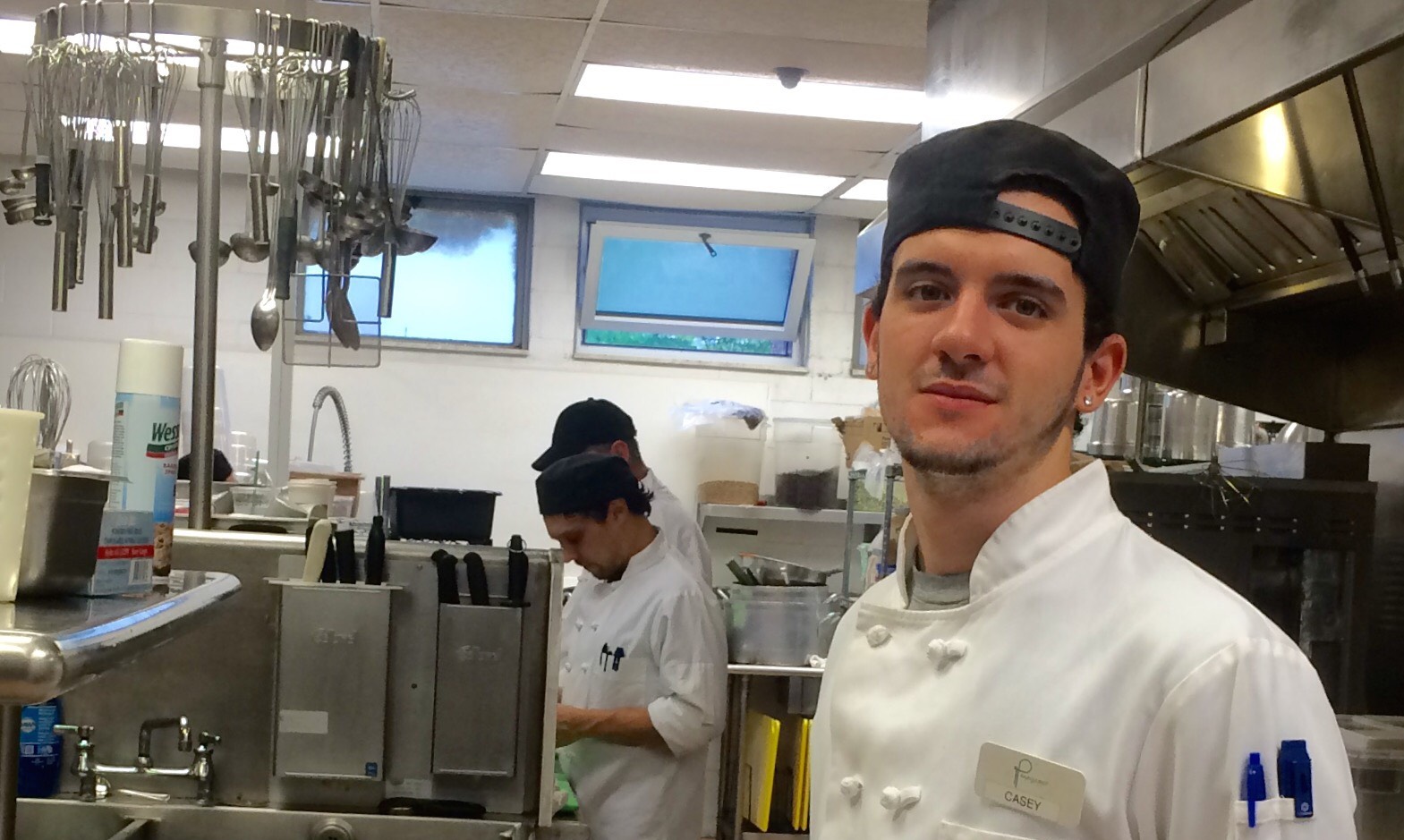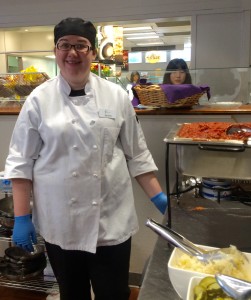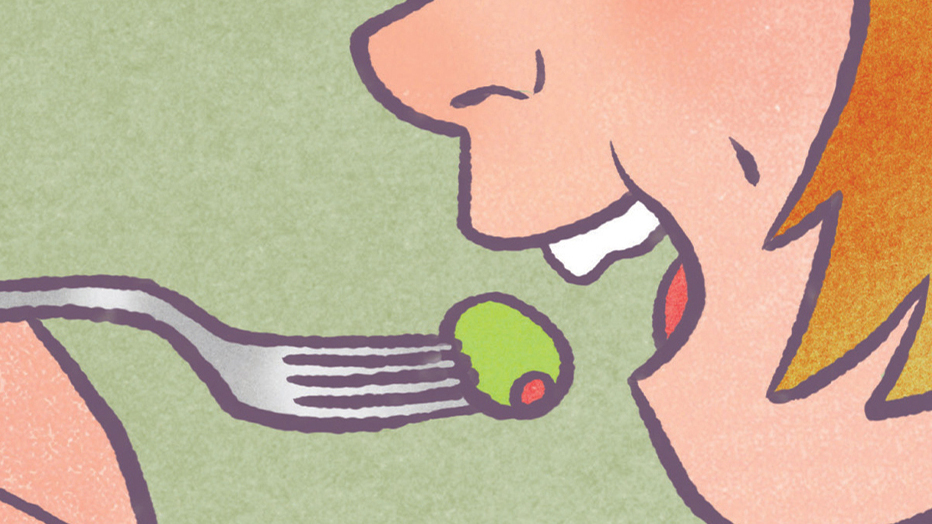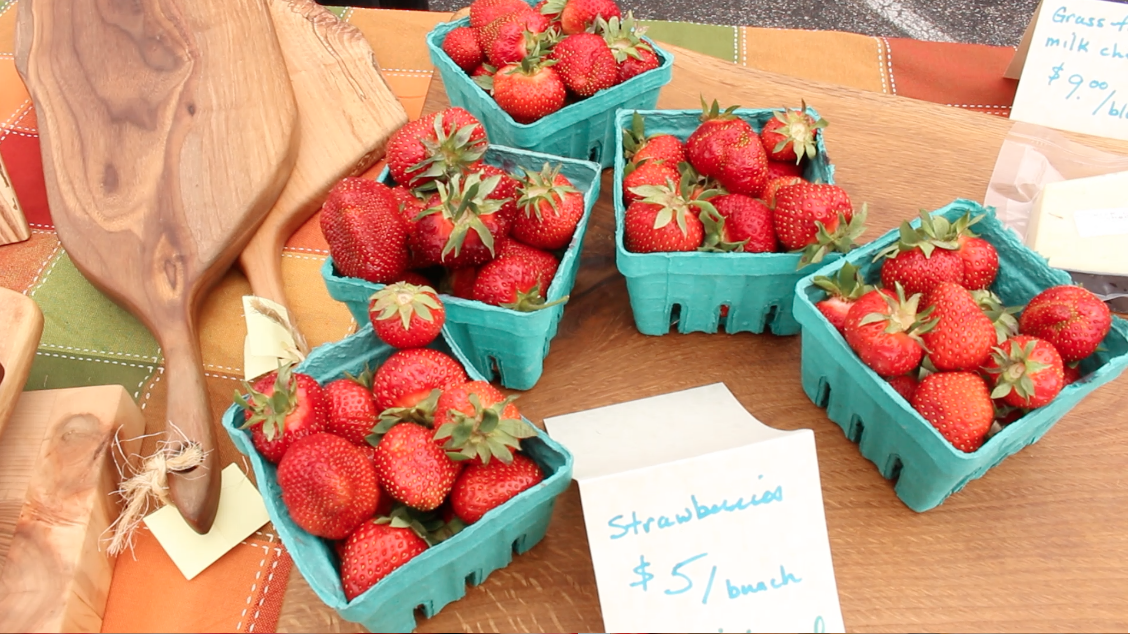With sixty percent of American adults having at least one food allergy, dietary restriction, or religious restriction, Chatham prides itself on catering to students that fit into this demographic. Chatham also heavily reflects on how these lifestyles affect the environment. Anderson Dining Hall uses a compost system; the napkins and straws are biodegradable, and, since 2009, Chatham has gotten rid of using trays.
However, some students who fall into the category of having dietary restrictions of any kind still often find themselves struggling. Monii Peters, a sophomore student, has multiple restrictions that Chatham fails to cover.
“I have a very restrictive diet now and am extremely limited at both Anderson and Cafe Rachel,” Peters says, “If it doesn’t have nuts, it has soy or dairy and vice versa. Those of us with food allergies and sensitivities are struggling to eat while wasting money on a meal plan we don’t use. That’s the story of my life.”
Rob Coyne, who became the General Manager of Parkhurst Dining Services at Chatham in February of this year, has been working with the Chatham community to make changes to the meal experience to accommodate new students and make the dining services more efficient.
“[The meal experience] is based on what the students tell me. I encourage anybody who presents to me with dietary restrictions to let us know that they have those restrictions so we can work with them,” he said. “We can’t offer every item for every student every day based on everyone’s dietary restrictions. There just wouldn’t be enough food for everyone to like. So if we have something they are allergic to, if we have a breaded chicken, and they’re allergic to gluten, they are a celiac, they let the server know, the Chef and we’ll make sure they get something to eat. I guess the best way to put it is the student meal experience is what they want to make of it.”
However, students such as Fiorella Nicoloso, a senior who is a pre-diabetic, say it’s not that easy.
“When I’ve tried to bring up health related things, nobody has emailed me back, ever. Which is frustrating, when I’m just trying to be healthy,” said Nicoloso.
Lynzy Groves, a junior student with a gluten allergy, agrees and says she’s also been trying to see change for nearly three years. When Groves started as a first-year student at Chatham, she was a size 4. Since then, she says she loses around 10 pounds every fall when she comes back to school due to lack of options. She is now a size 00 without attempts to diet or exercise.
“Having a gluten allergy makes eating at Anderson very difficult. I have been trying for the three years that I have been here to get more gluten free (GF) options at all of the meals,” Groves said. “Unfortunately, it has only gotten worse every year. Every time I or any of my friends who aren’t GF write a comment card asking for more GF options, we usually get negative feedback with the statement that there aren’t enough people with gluten allergies to make changes to the menu.”
“This is ridiculous,” Groves continued. “I am not asking for everything to be GF. I just want to eat something other than the salad bar and cooked vegetables. Every week I waste between 3 and 5 meals on my plan just because Anderson doesn’t offer anything that I can eat other than lettuce and veggies. One cannot survive on salad alone.”
Coyne admitted that, unless the Chatham population in need of this special menu presents itself, there will not be much of a menu change.
“If I know that within our student population I’ve got 35 percent people that are celiac, that gives me [the ability] to focus on the menu a little more.” said Coyne. “But for 2 to 3 percent of people it’s easier to do one on one instead of trying to design a menu around 4 or 5 people when we’re feeding 400 at lunch, 300 to 400 at dinner.”
“I am lactose intolerant, allergic to radishes and mushrooms and have an intolerance to gluten,” said Kelly Nestman, a senior who is also allergic to all seeds and nuts. “At Anderson, it is very hard for me to find things to eat that fill me up and are healthy. To find food that is filling I find myself bringing Lactaid pills to every meal, which costs $18 for 60 of them, and I take two every time I eat dairy and that adds up quickly. Or I have to eat gluten, which then makes me sick later. While yes there are arguments that there is a salad bar, it is rarely changed, and the food sits out all day, and I constantly find flies on the things on the bar. There is a ‘gluten free’ section of items, but every time I check they are stale, old, and sometimes moldy. I have had such a hard time being able to eat a meal there that is healthy and doesn’t make me sick.”
Though it’s not clear exactly how many students it will take for there to be a meal change for students with a gluten or wheat allergy, more common restrictions such as vegan and vegetarian have more attention. Even Chatham’s Office of Sustainability expresses that many students fall into this category. The Sustainability Culture page states, “The dining hall provides vegan and vegetarian selections at all meals to accommodate the large population that prefers this low-carbon diet, as well as to reduce the campus footprint.”
The dining hall contains a deli for sandwiches, a station for pizza or single serve dinner dishes, a grill, a bar for the main entrees, a Vegan and Vegetarian bar, a salad bar, and, during lunch, Casey’s Kitchen. However, with the food that is currently in Anderson, students say that it’s not quality, and there are few options.
“I’ll eat cucumbers and fruit as a meal because I have no other options,” said Peters, “[Chatham’s] ‘vegetarian’ and ‘vegan’ options are such a joke. It’s always squash and pasta.”
A typical meal on the vegan and vegetarian bar consists of cooked pasta and marinara sauce, and an entree that is usually Middle Eastern such as baba ganoush or falafel.
Nestman agrees that there isn’t much when it comes to the options for those who do not eat any animal byproducts, whether by choice or for medical reasons.
“The vegan options are not high quality and seem to be considered an afterthought with whatever ingredients that are extra or lying around,” said Nestman.
“All too often [the vegetables] are very overcooked or very undercooked, and when that is one of my only ‘healthy’ options available, this is incredibly frustrating,” said Nicoloso.
Nadia Frock, a first-year student, is also frustrated with what is considered an acceptable meal. “Half the time the vegetarian soup isn’t actually vegetarian, and they think that cheese is a meal.”
“The cafeteria is our only option because we don’t have a stove,” said another first year Melanie Landsittel, who is a vegetarian who lives on upper campus in Fickes residence hall. She is also a part of the Vegan/Vegetarian committee. “The quality of the vegetarian food is not good.”
For those residents who live on lower campus, in graduate housing, and are commuters, the meal experience can be very different from upper campus residents. Instead of eating every meal in the dining hall, they often only experience one or two meals in Anderson. Some don’t experience any meals at all.
For Bethany Hagensen, a commuter, she has the option to eat at Anderson but chooses not to.
“I live off campus and ate one meal at Anderson one time,” she said. “I was told there were vegan options when I toured the campus last spring, but the only vegan thing on the menu was the salad bar. I wouldn’t complain if there weren’t students locked into a meal plan that have to eat three meals a day, every day basically from an Eat’n’Park quality salad bar. More options, please. How about putting a few vegan and allergen-free entrees that change routinely on the regular menu?”
There has also been an issue in the dining hall where, on nights when there are specials such as a taco bar, French fry extravaganza, or a hot dog bar, the food is put on the designated vegetarian/vegan bar. Coyne says that in these circumstances, it really comes down to space.
“That’s kind of the way it’s been done here for a while now. While we always keep a vegan or a vegetarian option over there, when we do bars and things, the space is very limited for what we have and what we are able to put out,” he said. “You know, I don’t have an additional area where I can set up another bar and put some of those things so yes, there are times when we need to [repurpose the space].”
Having non-vegan and vegetarian food on this bar happens to be a factor within another frustration of students with restrictions and even students without: labeling. An issue that has been brought up amongst students is the labeling, or lack thereof, in the dining hall. There are small signs that state whether a dish contains nuts, fish, soy, etc. or is vegan, vegetarian, or gluten-free approved. However, when staff inappropriately use these signs, students with restrictions get the worst of it.
“Anderson needs to label the dishes with allergens or applicable dietary restrictions. I know a lot of people that expect vegetarian food in the vegetarian serving area. Instead, there are salads or sauces with alcohol, meat, or pork,” said Maryem Aslam, a junior commuter student who relies on labeling for religious purposes.
“The major problem with Anderson is that they do not understand what GF means,” said Groves, “Many items are mislabeled if they ever are labeled, and items in the GF section are actually not GF. Rice Krispies contain malt, which is wheat/gluten. And, the Rice Chex were mixed with Corn Chex in the same cereal dispenser which makes it no longer GF. Gluten allergies are a real thing. Don’t write it off as a diet until you get violently ill with an allergic reaction from eating something that was mislabeled. If Anderson took wheat and gluten allergies as seriously as they take nut allergies, the world would be a better place.”
The meal restrictions don’t stop at Vegan/Vegetarian. Nicoloso says she just recently learned she was pre-diabetic and tried to reach out to the dining hall over the summer but has yet to be able to get in touch with anyone.
“Hardly any, if any options in Anderson for any meal are diabetic-friendly. Basically no options in Cafe Rachel are,” she said. “Having recently received a diagnosis of pre-diabetes, I’m hyper-aware of this, and I’m really upset that I basically can’t use my meals to eat things that I physically should be eating.”
She says one of her main struggles is not being able to know the nutrition facts of the food she’s eating which forces her to take risks when trying to watch her sugar intake. Coyne says Parkhurst is working on it.
“As a company, Parkhurst Dining is working on a system that may not roll out until the middle of spring. There will be a website students can go to that will list all the stuff that we do on a daily basis,” he said. ”All the salad bar stuff will be listed there, all the different types of cereal options will be listed there. We’re also working on trying to plan our cycle menu. As long as the menus are in our database, there will be limited nutritional information about it.”
Coyne also says that Anderson is already making moves in cutting sugar.
“As a diabetic myself, I have to watch sugar and what kind of intake and what goes into my body,” he said. “They can always ask us, they can ask myself, they can ask any of the supervisors, they can ask Chef Dan. We generally tend not to use a lot of sugar in what we do depending on the cuisine. A lot of the Asian sauces are higher in maybe sugar. They do use some things in the sauces, but we tend not to use just sugar as an additive to sweeten something. We have a few pre-made dressings that we use. They tend to be a little higher in sugar like the raspberry vinaigrette. The low fat [dressings], yeah they take the fat out of it, but they make up for the flavor by adding a ton of sugar to it. Actually, along the salad bar, they have little stickers with [nutrition information] about most of the things in the salad bar. The best thing is just to ask, and then we can give them the answers they need.”
Unfortunately, this doesn’t address foods such as ketchup, potatoes, bread, fruits, and most carbs that are problematic for diabetics. However, Coyne does speak to the students who may feel like they don’t have an option at the dining hall.
“Talk to us. I don’t want anyone leaving here hungry,” he said. “Like I said to start, we can make something differently so that they don’t feel singled out.”
Coyne reiterated that there are too many types of restrictions to be able to cater to them all on a daily basis.
“Like I said, if we tried to do everyone’s onesy twosy dietary restrictions there wouldn’t be any place for food.”
Coyne says that he is working with Chatham Student Government to get more Vegan/Vegetarian options for students. He also says students can send in recipes.
“Right now Chef Dan plans most of the vegan and vegetarian options when he does his weekly menu planning. We are working with CSG to create a new vegan and vegetarian committee to get some more feedback. I know there’s been some concerns out there. We’re hoping to get that committee started sooner. If somebody gives us a recipe and says ‘hey, would you try that’ Chef Dan always does that. We’re definitely open to trying things and if they’ve got ideas for us [we’ll try them]. We want to plan around what the students want, some ideas on what they want to see. I know we’ve done that in the past.”
Maryann Fix, the head of the Vegan/Vegetarian Committee for CSG, confirms that the dining staff is working with her to create a better meal experience.
“I have been working a lot with Rob and Chef Dan, and they generally try to make sure I can find something to eat in Anderson. But I think a lot more could be done to meet the needs of gluten-free, vegetarian, and vegan individuals,” said Fix. “For example, Pitt has a whole station dedicated only to gluten free including a gluten-free grill and a different dish every day. We should have something like that because something that is gluten-free can also be easily vegan or vegetarian, like a quinoa dish.”
Though Fix compares the Anderson Dining Hall with the University of Pittsburgh’s Market Central, she makes it clear that she is not looking for anything out of the ordinary.
“None of us are asking for special treatment; we’re just asking to get what we pay for like everybody else does,” she said. “Just because someone has a dietary restriction, whether it is their choice or not, we are paying for these meals, and we should be able to find something that we are happy with at any time. We shouldn’t have to eat such similar things every day, either.”
Coyne welcomes students to bring their concerns to his office in the back of the dining hall. There are also comment cards in the dining hall that receive feedback and staff members who will provide students with something if specifically asked for such as a bowl of pineapples.
A student’s meal experience has a huge impact on their college experience. With studies, work, and co-curricular activities, having to worry about what one is going to eat should be the last thing on the list of priorities. Some would say that the current ways of the dining hall wouldn’t be so hurtful if the university didn’t advertise a diverse menu.
On the Chatham University and Parkhurst Dining Services webpage, Chatham says, “Parkhurst Dining Services understands that dining is an integral part of the college experience. That’s why we offer students a number of delicious and healthful dining options. Our dining plans provide the ultimate in flexibility and offer something to satisfy even the most discriminating tastes.”
Even in the tours for prospective undergraduate and graduate students, tour guides are told to point out that Chatham has wonderful options for everyone.
“We definitely have to say that [Chatham] has vegan, vegetarian, and kosher options for every meal when we take a tour through Anderson. It’s on the script,” said McKenzie Gordon, a former student worker at the Admissions Office.
The current system has a lack of options, mislabels food, and causes students to alter the state of their health. Many students ask, what will it take to make a change?
“They need to start considering the ramifications of their actions because someone could die,” said Groves, “I’m not joking.”




